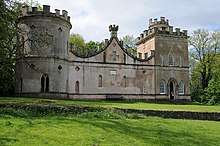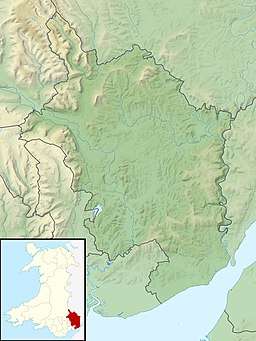Clytha Castle
Clytha Castle (Welsh: Castell Cleidda) is a folly near Clytha between Llanarth and Raglan in Monmouthshire, south east Wales. One of the two "outstanding examples of late eighteenth century fanciful Gothic in the county",[1] "this stupendous folly enjoys magnificent views to the mountains of the north-west, Skirrid and Sugar Loaf."[2] The castle is a Grade I listed building as of 1 September 1956.[3]
| Clytha Castle | |
|---|---|
 "the Taj Mahal of Wales" | |
| Type | Folly |
| Location | Clytha, Monmouthshire |
| Coordinates | 51.7706°N 2.9232°W |
| Built | 1790 |
| Architect | John Davenport |
| Architectural style(s) | Strawberry Hill Gothick |
| Governing body | Landmark Trust |
Listed Building – Grade I | |
| Official name: Clytha Castle | |
| Designated | 9 January 1956 |
| Reference no. | 1968 |
 Location of Clytha Castle in Monmouthshire | |
Location
Clytha Castle is set close to the A40 Abergavenny to Raglan road, originally within the parkland that formed part of the estate of nearby Clytha Park, some four miles west of Raglan. The Monmouthshire antiquarian Sir Joseph Bradney, in his multi-volume A History of Monmouthshire from the Coming of the Normans into Wales down to the Present Time, records that the castle was connected to the park by a carriage drive that crossed the Clytha Gorge via a suspension bridge.[4] The setting gives "magnificent views" across the valley to the Skirrid and Sugar Loaf Mountains.[5]
History and description
Clytha Castle is a crenellated stone folly with gothic windows set on a rounded hill, amid chestnut groves, overlooking Clytha Park and the River Usk. It was built in 1790 by William Jones of Clytha Park in memory of his wife.[6] William Jones engaged John Davenport, an architect based in Shrewsbury to design the castle, built "for the purpose of relieving a mind sincerely afflicted by the loss of a most excellent wife".[6] A tablet set into the walls of the folly records this dedication.[2]
The folly experts Gwyn Headley and Wim Meulenkamp describe the architectural style as "a late fling of Strawberry Hill Gothick” and consider the building "the Taj Mahal of Wales".[7] Built of rendered rubble stone with Bath stone dressing, the plan is "L" shaped, with a square, two-storyed central block, with screen walls and drum towers to either side.[2] It is exquisitely proportioned with picturesque asymmetry and located in a landscape that balances the building and complements it. "Everything is big and simple, to (be) read from a distance."[2] The round tower is roofless and was designed as a shell in order to add symmetry to the facade.[8] John Claudius Loudon, horticulturalist and historian of the Picturesque was not impressed, describing the folly as "gaudy and affectedly common".[5] The Cadw listing record describes Clytha Castle as "one of the outstanding 18th century follies of Wales".[3]
Clytha Castle is in the care of the Landmark Trust, which has maintained the building since 1974, and is available to rent.[9]
Notes
- Newman 2000, p. 190.
- Newman 2000, p. 192.
- Cadw. "Clytha Castle (Grade I) (1968)". National Historic Assets of Wales. Retrieved 24 March 2019.
- Bradney 1992, p. 118.
- Jenkins 2008, p. 170.
- Bradney 1992, p. 117.
- Headley & Meulenkamp 1999, pp. 102-103.
- Keen & Burgum 1997, p. 134.
- "Holiday at Clytha Castle, near Abergavenny in Monmouthshire – The Landmark Trust". www.landmarktrust.org.uk. Retrieved 6 January 2019.
References
- Bradney, Joseph (1992). A History of Monmouthshire: The Hundred of Raglan, Volume 2 Part 1. Academy Books. ISBN 1-873361-15-7.
- Headley, Gwyn; Meulenkamp, Wim (1999). Follies, Grottoes and Garden Buildings. London: Aurum Press. ISBN 9781854106254.
- Jenkins, Simon (2008). Wales: Churches, Houses, Castles. London: Penguin. ISBN 978-0-713-99893-1.
- Keen, Richard; Burgum, Ian (1997). Wales. London: Orion Publishing Group. ISBN 9780753802083.
- Newman, John (2000). Gwent/Monmouthshire. The Buildings of Wales. London: Penguin. ISBN 0-14-071053-1.
External links
- The Landmark Trust – owners of Clytha Castle today